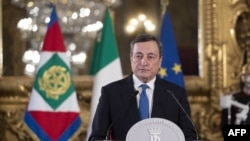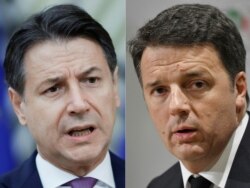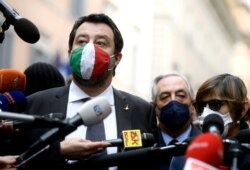Italy’s president has turned to a former banker dubbed “Super Mario” to set up a government of national unity to replace a shaky coalition that collapsed last week amid infighting.
The selection of 73-year-old Mario Draghi to head a “technical” government is prompting the question: Can he save Italy from economic collapse much as he saved the euro, Europe’s single currency, while head of the European Central Bank in the aftermath of the 2008 global financial crash?
Draghi helped to soothe financial markets after the crash and defended the euro by emphasizing the bank would do “whatever it takes” to preserve the currency.
Italian President Sergio Mattarella said Tuesday he had asked Draghi to accept the mandate and appealed to “all the political forces in the parliament” to support a “high- profile government” to meet the historic moment.
Draghi now will negotiate with fractious party leaders to see if they will help him shape a new government. Italy’s stock market rallied on Wednesday in response to the news. Italian bond yields dropped after Draghi said he would seek to form a new government, reducing borrowing costs for Italy.
Last week, Giuseppe Conte, an obscure academic who proved a deft political operator, resigned as prime minister. That came after his uneasy and squabbling coalition government lost the support of a junior center-left governing partner, plunging the pandemic-struck country into fresh political turmoil.
The crisis was triggered by Matteo Renzi, another former prime minister, who clashed with Conte and the main coalition partners, the eclectic anti-establishment Five Star Movement and the center-left Democratic Party, over how to spend more than $200 billion in EU funds to boost Italy’s recovery from the pandemic.
Renzi’s gambit was widely seen as a ploy to grab more power for his diminutive breakaway left-wing Italia Viva Party, which attracted 2% of the popular vote and has more than a dozen senators — enough to deprive Conte of a majority in the upper chamber of Italy’s Parliament.
“To overcome the pandemic, to complete the (coronavirus) vaccine campaign, to offer answers to the daily problems of the citizens, to relaunch the country are the challenges we face,” Draghi said Wednesday after meeting with Mattarella at the Quirinal Palace in Rome.
The president could have chosen to announce a snap general election, which would have prolonged political turbulence. An early election would likely see former Deputy Prime Minister Matteo Salvini’s populist Lega Party, and the far-right Fratelli d’Italia (Brothers of Italy), both Euro-skeptic, storm to victory — an outcome that would prompt jitters in Brussels and lead to complications with the Democratic administration in Washington.
Mattarella said Italy could not afford to be distracted by an election campaign and noted his worry about the coronavirus being spread more widely through party rallies.
The last time a technocrat was appointed to head an Italian government was in 2011, when Mario Monti, a former European Union commissioner and academic, steered the country out of an acute sovereign debt crisis and set about labor reform.
Italy’s mainstream media largely welcomed Mattarella’s move. La Stampa newspaper's chief columnist, Massimo Giannini, said Draghi’s appointment was Italy’s “only hope.”
Italy was among the first European countries to be struck by the coronavirus and was the first to impose a national lockdown because its infection rates rose much more quickly than in neighboring countries. After the government loosened restrictions, infection rates soared, with the second wave proving worse than the first. Strict pandemic restrictions over Christmas have slowed contagion rates but added crippling costs to the country’s struggling economy.
Italy has seen more than 2.5 million COVID-19 infections so far and has recorded 89,344 deaths, according to Johns Hopkins University.
“The parliament remains deeply divided, and the new government will have to rely on a diverse and fractious coalition with nothing in the way of a shared ideology or policy platform. Advancing divisive, politically costly reforms will remain a challenge,” Federico Santi, a senior analyst at Eurasia Group, said in a commentary.
Draghi said he is confident “unity will emerge.” But the Five Star Movement, the biggest party in Parliament, has said it will not back a “technical” government led by Draghi, arguing a political government was the only solution.
However, Nicola Zingaretti, leader of the Democratic Party, has left the door open.
“Draghi’s appointment opens up a new phase that could lead the country out of the uncertainty created by an irresponsible and absurd crisis,” he said.
Salvini has frowned on Mattarella's decision, and repeated his demand for a snap election. Former prime minister and center-right Forza Italia leader Silvio Berlusconi said he has “longstanding esteem” for Draghi and suggested he would back the new government.
Renzi is also supportive, writing on Facebook, “Now is the time for sobriety. No more polemics. Long live Italy.”







